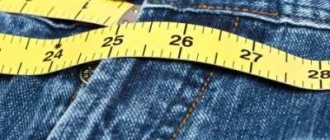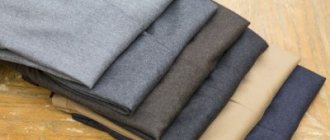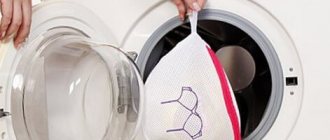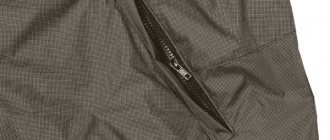A bologna jacket is considered one of the most practical and popular items in the wardrobe. This outerwear is very light and comfortable, and the material itself is moisture-resistant, will not let you get wet in inclement weather and will protect you from strong winds.
Such jackets have many advantages. And we really want this product to be worn for more than one season. And so that your clothes do not lose their colorful appearance, try to immediately take measures to remove newly appeared stains. It is not necessary to take the product to the dry cleaner; you can try cleaning your bologna jacket at home.
How to use an automatic machine for different types of jackets
Today there is a fairly wide selection of winter clothing made from different materials, each of which has different rules for caring for it.
A responsible approach to cleaning warm clothes will allow you to look beautiful and tidy for more than one season. If you know how to wash a down jacket with tennis balls, how to care for a parka, and why you need to turn the jacket inside out before washing, you will be able to maintain the functionality and attractiveness of your products for a long time. Let's look at which washing methods are most suitable for outerwear with the most common fillings.
Sintepon
Synthetic winterizer is considered a universal material, characterized by high wear resistance and excellent resistance to mechanical stress. If you already know how to wash winter jackets in a washing machine, you can safely put the padding polyester product in the drum.
If you are in doubt about how to wash properly, always choose a delicate program and make sure that the temperature does not exceed forty degrees. For a synthetic jacket, you can set the manual, quick wash or program for synthetics. To ensure that the product remains streak-free at the end of the process, take care of an additional rinse.
Remember that synthetic winterizer does not tolerate spinning well, so it is better not to use it. If necessary, use only low speed. It is better to dry the jacket vertically for good air circulation.
Downy
Down jackets are very comfortable to wear, retain heat well and are easy to clean at home. If you are wondering how to wash a down jacket in a washing machine with tennis balls and what it is for, we will certainly tell you.
A feature of things made from down is the tendency of the filler to form lumps. You should place special or felt-covered tennis balls in the drum. They are needed for washing a down jacket so that it does not bunch up. In the process of rotation, the balls beat off the down jacket, and the filling is evenly distributed throughout the product. A reasonable question arises about how many tennis balls are needed for washing. Three will be enough.
Choose a delicate cycle for washing a jacket with down filling and a temperature of 30 degrees. For spinning, use low speed, up to a maximum of 600 per minute. A thorough rinse is recommended to completely remove any detergent residue.
Bologna
Skillful housewives know how to wash a bologna jacket so that it remains attractive in appearance and does not lose its functional qualities. It is not as capricious and demanding as other types of jackets, but you should still be careful when removing dirt in an automatic washing machine.
It is necessary to select a delicate mode at a low temperature, use a gentle gel detergent and provide for the possibility of an additional rinse to finally get rid of its residue. It is advisable to refuse spinning or give preference to low speeds so as not to damage the product. Excess water will quickly drain during drying.
Polyester products
Clothing made from polyester is quite unpretentious and easy to care for. But you should still adhere to some rules so as not to accidentally spoil it. Considering how a jacket is washed in an automatic washing machine, choose a delicate program and a low temperature setting of up to forty degrees, since too hot water has an adverse effect on this fabric.
Try not to use spinning or machine drying. If desired, add conditioner to help maintain volume and prevent static. A polyester sports jacket should be dried by hanging it away from heating devices and direct sunlight.
Parka
These comfortable, stylish and practical winter jackets are easy to clean in the washing machine. It is recommended to split the process into several stages. On the first one, start a cycle with cold water, turning on the delicate mode without using a spin cycle. Then wash the parka at a temperature of 30-40 degrees, adding liquid detergent.
To avoid deforming the air filler, place tennis balls in the drum for washing down jackets. Dry the parka horizontally, allowing the water to flow down freely. It is advisable to dry it in the open air, beating the product by hand from time to time.
Methods for straightening padding polyester in a jacket after washing
After being in the washing machine, synthetic clothing needs to be straightened. This can be done simply by hand. For this purpose, the jacket should be shaken with your fingers, then laid out horizontally, giving the product the correct shape.
In some cases, a regular carpet beater will come to the rescue. After the item has dried a little, it needs to be hung on a hanger, and then lightly beaten. As a result of these actions, the padding polyester filler will straighten out and take on its original appearance.
In the most difficult and neglected situations, the beater can be replaced with a vacuum cleaner, with which the entire surface of the jacket or coat should be treated. This method is suitable if the down jacket is still damp.
Method 2 of 3: Washing with a washing machine
Read the label on your clothing. Select the gentle cycle on your washing machine for clothes made from stiff fabrics that are not susceptible to warping. Cotton, linens and polyester materials will generally withstand machine washing.
On this topic:
Set your washing machine to the gentle cycle. The water should be cold, not warm or hot. Use a mild detergent to wash your clothes. Wash dry-cleanable clothes only on the most gentle cycles.
Remove items from the wash as soon as the cycle ends. Place them on the drying rack or hang them up to speed up drying.
Method 3 of 3: Dry cleaning at home
Buy a dry cleaning kit at home. These kits come with a bottle of stain remover, dry cleaning sheets and a dry cleaning bag.
Read the clothing label. Dry cleaning kits are suitable for silk, polyester and other delicate fabrics that are not too dirty. If the problem is serious, it is better to take the clothes to the dry cleaner.
Use stain remover to clean stains. The stain remover that is sold with stand-alone cleaning kits is the same as the stain removers you buy at the store on a regular basis. Apply it according to the instructions that come with the kit.
If you are concerned that the stain remover may leave marks on your clothing, test in a hidden area to ensure that the stain remover is safe for the fabric of the garment.
Do not use stain remover on large stains. If the stain covers a significant portion of the item of clothing, it is a direct route to a commercial dry cleaner, do not attempt to remove such stains at home.
Place the clothes in a dry cleaning bag. Add dry cleaning sheets inside. The sheets release fragrance and some moisture to help refresh clothes during the dry cleaning process.
Place the bag in an electric dryer. Run the gentle dry cycle, making sure the dryer is set to the lowest setting. When the cycle is finished, remove the bag from the dryer.
Place the clothes on the hanger. While the clothes are hanging, any residue will “fall off” and the home dry cleaning process will be completed.
You may also be interested in the article:
Temperature selection
If you care about the safety of the item, then there is no need to talk about high temperatures when washing. It is better not to install above 40 degrees. For particularly delicate fabrics, 30°C water is preferable.
Additional Information! Windbreakers designed to protect the body from rain and wind can be made from different fabrics. The composition of the material dictates the choice of washing temperature.
- Polyester is a material created artificially from the melt of polyester fibers. It has excellent weather-resistant qualities, durability, does not allow rain and wind to pass through, and does not wrinkle. But in accordance with the nature of its origin, it is afraid of high temperatures. Hot water can “melt” the structure of the fabric, causing the item to become deformed and shrink in size. So in this case, wash at a maximum of 30 degrees.
- Nylon is also a synthetic material obtained through chemical manipulation of molecules. It is older and stronger than polyester. Holds paint better. However, it is not resistant to high temperatures: it wrinkles and stretches greatly. Therefore, it is necessary to wash at no more than 40 degrees.
- Corduroy and cotton. Windbreakers made from these materials contain natural fabrics. They are warmer and can withstand washing at 60 degrees.
Non-standard approach
In addition to the usual methods of ironing with household appliances familiar to everyone, there is a non-trivial but effective folk method. It consists of the following:
- place the jacket on hangers and fasten it;
- We bring it into the bathroom and open the tap with hot water (it is advisable to use boiling water);
- We leave the item in the room and close the door tightly;
- after 15 minutes we go in, close the tap and pick it up;
- dry in the open air.
Another method of operation is similar to the previous one:
- take old newspapers or paper, crumple it up and stuff it tightly into the sleeves of your jacket;
- hang in a room with high humidity (bathroom or kitchen);
- straighten out all the irregularities and folds with your hands;
- Place a bowl of boiling water underneath; The steam will rise and straighten the fabric.
The proposed option will make it possible to do without newfangled steamers, and will also protect you from the possible consequences of regular ironing.
It is clear that even such a harmless method can be destructive for some fabrics. For those who are afraid to take risks, it is safer to take your outerwear to the dry cleaner. They will quickly and efficiently restore the appearance of your favorite clothes. There are more than enough ways to iron polyester products, and everyone chooses the one that seems most optimal to him. The main thing is to do everything carefully and carefully, having first read the manufacturer’s recommendations on the label.
Is it possible to iron and steam?
If properly dried, a bologna jacket does not even need to be ironed. But if the item that has been lying around is wrinkled, you can smooth it out using steam or an iron.
- You can straighten a bolognese product with steam by hanging it in the bathroom and turning on hot water, from which steam emanates. By saturating the material, it will straighten out all the folds.
- Using an iron, the item is ironed from the wrong side through gauze. The temperature is set to the lowest, steam generation is turned on.
If you don’t have the desire or ability to iron a jacket or raincoat yourself, you should resort to dry cleaning services.
Useful tips
Owners of things that can fade when washed will do well to familiarize themselves with useful tips that can be adopted.
They are as follows:
- Do not immerse the entire item in an ammonia solution; first, test the effect of the solution on an inconspicuous area of fabric or a similar piece of material;
- for woolen products, add dry mustard powder to the detergent;
- silk clothes should be washed in water in which bran is soaked;
- beige, cream or brown products after rinsing can be kept for some time in tea leaves, poured with boiling water in such a proportion that the color of the liquid is not darker than the product;
- If a green or black product has lost its original color, a solution of alum will help return it to its original color;
- Vinegar applied to a cotton pad can remove light traces of dry deodorant on a dark product;
- try not to twist the fading clothes too much; you should wrap them in white material and then wring them out;
- dry the product in the courtyard or on the balcony, away from direct sunlight, so that the fabric does not fade;
- Before hanging the item outside, turn it inside out so that the color of the item is not damaged by ultraviolet rays;
- clothes made of delicate fabrics with combined shades should only be dried horizontally, laid out on a sheet or fabric that absorbs moisture well;
- when ironing a product that can shed, you need to use the thermoregulation function;
- You can’t use soda for things that shed;
- If the product label does not indicate machine washability, wash the item by hand;
- always read the manufacturer's washing recommendations;
- at the stage of purchasing an item, ask the seller whether the product is capable of shedding in order to make the right choice;
- Before washing, clothes are turned inside out and fastened with zippers or buttons;
- before the process, do not soak the product in detergent diluted in hot water;
- the optimal water temperature in which the product can be washed is no more than 30 degrees;
- When using the machine method, always select a gentle wash cycle without using the spin option.
That's all the tricks. We sincerely hope that they will greatly simplify your life and allow your products not to fade when washed. Treat fading items with care, and then they will serve you for a long time.
Proper drying
Careful preparation of the item, the right mode and the right detergent will not save your favorite jacket if it is not dried correctly. This stage requires special care.
Firstly, the almighty shortcut will tell you whether there are any peculiarities in drying a particular item. On it you can find symbols for vertical or horizontal position, as well as recommendations for using machine drying.
Secondly, you should always take the washed jacket out of the machine right away. Do not leave it overnight. An unpleasant smell is guaranteed to accompany the owner of the item everywhere. And the wet filler cakes quickly.
For some items, the manufacturer does not recommend spinning even manually. In this case, you need to hang the jacket on a rope and place a basin under it. After some time, the water will drain and you can hang the item on hangers.
For thin nylon windbreakers, it is worth choosing hangers according to size. Better - plastic, repeating the shape of the shoulders. A wet item may become deformed at the protruding parts of an unsuitable hanger.
How to dry a down jacket
The down jacket should be wrung out without twisting: the compressed clumps of down will then be difficult to straighten out. Hang on hangers.
The main rule is to shake the item as often as possible during the entire drying time. This will help avoid stagnation and ensure ventilation of the internal filling. Constant hand beating promotes the evaporation of moisture, the jacket “inflates”, filling the space between the feathers with air. Packed lumps of filler disrupt the thermal properties.
Short-term methods will not work here: if you hang a jacket on a radiator, hard, dried lumps will form inside, and a hot, directed jet from a hairdryer will also do harm. The highly heated surface of the iron deforms the upper fabric, which most likely contains synthetic fibers.
Advice! Do not iron a down jacket. Feathers and down will straighten out during wear and provide the correct shape to the product.
Jackets made of holofiber and padding polyester
These materials like to dry vertically with ventilation, allowing air movement from all sides. Dries quickly.
How to wash a shiny jacket
A good way to wash a greasy collar or cuffs is to treat them with a mixture of dish gel and baking soda. Mix soda with detergent to form a paste. Then rub this paste on the damaged areas of the fabric and leave for 10-15 minutes. After this, the clothes can be rinsed in cool water and put into the washing machine.
Dish gel + soda
But if you don’t like to use aggressive chemicals, or the material of the jacket is delicate, then you can try to remove dirt using improvised means that have been tested by every housewife. A Bolognese jacket can also be cleaned using traditional methods.
Such jackets have many advantages. And we really want this product to be worn for more than one season. And so that your clothes do not lose their colorful appearance, try to immediately take measures to remove newly appeared stains. It is not necessary to take the product to the dry cleaner; you can try cleaning your bologna jacket at home.
A bologna jacket is considered one of the most practical and popular items in the wardrobe. This outerwear is very light and comfortable, and the material itself is moisture-resistant, will not let you get wet in inclement weather and will protect you from strong winds.
We fight old stains of unknown origin
- Table vinegar can help us in the fight against unpleasant shine. Moisten a cotton swab with liquid and lightly rub the desired areas of the jacket. Ready. Don't forget to ventilate the product to remove the vinegar smell.
- Baking soda also works well for greasy areas. The cleaning principle is the same as with vinegar.
The well-known white spirit will become an indispensable assistant not only during repair work, but also in removing grease from outer clothing. To clean the jacket, you need to carefully treat the contaminated area with a swab soaked in the solution, then leave the item for 5-10 minutes to dry. You can remove the gasoline smell from the collar using a soap solution at room temperature or a scented wet wipe.
At the end of the cold season, many are faced with sweat and grease stains appearing on their collars. You can easily wash greasy areas on your jacket, either using store-bought products or using improvised preparations at home. In addition, there are winter clothes that cannot be washed in a regular washing machine, and hand cleaning will come in handy. This process will not take much time and will significantly save the family budget, because the services of specialized institutions, dry cleaners, are not cheap.
Alcohol and table salt
- At the initial stage, you need to find out the type of fabric from which the clothes are made and instructions for caring for the affected product, since not all materials are suitable for aggressive cleaning agents.
- The next step in solving the problem will be a careful study of the composition of the cleaning substance. Typically, manufacturers indicate on the labels the basic rules for using and preparing the required concentration to remove certain types of stains.
- Dry the treated jackets in natural conditions, since drying on heating devices can lead to deformation of the item.
Removing stains step by step:
- Dilute a cap of the selected product in a large bowl of lukewarm water.
- Soak the product in the solution for 4 hours. It is not worth keeping the item in the product for too long.
- After soaking, you need to thoroughly rinse the jacket or down jacket in plenty of water, changing it several times.
- Wring out the item in the washing machine and hang it to dry.
Our grandmothers used glycerin in everyday life to remove stains from things. A cotton swab should be soaked in liquid glycerin, which is sold in pharmacies, and applied to all affected areas on the product. After 15 minutes, the item must be washed with soap or powder, or put in the washing machine.
Folk remedies
If it is not possible to use aggressive chemicals for washing, then you can try using folk recipes. Sometimes improvised means are much more effective than expensive powders and gels.
High-quality cleaning compounds are produced under the Heitmann, Dr. brand. Beckmann, NIKWAX. Excellent specialized preparations for cleaning outerwear can be bought in Korean and Japanese household chemical stores.
Removing nasty grease stains from a bologna jacket
- Regular, “Soviet” laundry soap will do an excellent job with a fresh greasy stain. Lather the dirty area. If you're not in a hurry, leave the jacket lathered overnight. This way the effect will be better. Then wash the product as usual.
- You can sprinkle table salt for a while. It will absorb greasy dirt well. If the greasy stains are not removed the first time, add more salt until the stain disappears.
- If your jacket is made of light-colored material, then oil stains from the jacket can be removed with ammonia. Dampen a clean cloth with the liquid and rub only the areas that need to be cleaned. Otherwise, other places will become discolored and the jacket will be damaged.
- There is a way to remove greasy stains from a Bolognese jacket using dry mustard powder. Pour two tablespoons of mustard into a small container and dilute with water until you obtain a sour cream-like slurry. Apply the mixture to greasy stains and leave for an hour. Then wash the jacket with soapy water.
- A good cleaning agent for a bolognese jacket is regular table vinegar. Soak a cotton pad in vinegar and apply to problem areas. Next, hand wash your item.
Preparation and external cleaning
Before external cleaning, it is necessary to prepare:
- Study the nature of the contamination. In greasy places there may be other stains: from cosmetics, food, dyes.
- Before using the stain remover, find out if the product is fading. Apply the product to an inconspicuous area, wait a while, and rinse with water. If there are no changes, you can clean the entire surface of the item.
The cleaning method depends on the nature of the stains.
A greasy jacket is cleaned with household chemicals and more:
- "Vanish." The product is applied to the dirt, left for 10 minutes, and wiped off with a damp cloth.
- Spray K2r. It is used to remove stain without washing. After spraying it, a powder is formed, which is cleaned off the surface.
- Dishwashing liquid. Foam is created, which is used to treat the cuffs, collar area, area around the pockets, etc. After 20 minutes, the item can be washed as usual.
- Table salt, which is used to cover greasy stains. The product works better if the stain is fresh.
Dry wash and stain removal
If your bologna jacket shows occasional greasy or dirty spots, you should clean it locally using dry cleaning.
To do this, prepare:
- wet wipes or a soft, clean cloth;
- stain remover (in extreme cases, purified gasoline will do);
- Additional soap-based stain remover.
Procedure:
- Using a cotton swab dipped in stain remover, wipe the stains effortlessly.
- If you fail to clean the product the first time, wait until it dries, then process it again.
- After removing all dirt, the item will need to be washed.
Step-by-step instructions on how to wash by hand
Before you start washing, prepare all the necessary attributes: a bowl of water, powder, gel or soap, a brush, clothespins. Additionally, you may need a stain remover or bleach. Provide an adequate supply of water if there is no centralized water supply.
Sort your clothes, placing white and colored items, silk, wool and other materials separately. Inspect the pockets and remove all contents.
How to wash when hand wash:
Prepare two basins with water at the optimal temperature. One container will be needed for washing, the second – for rinsing things. Place the basin on a chair so that you don't have to bend over - this will avoid back pain. Dissolve the detergent using the recommended dosage according to the instructions on the package. Immerse items in water and scrub lightly. If necessary, use a brush, but do not overdo it so as not to damage the material.
When hand washing a white shirt, pay special attention to the cuffs and collar, and when washing trousers, to the bottom of the item. Soak the items for several hours, but do not leave them for long to avoid the development of an unpleasant odor. Rub items together while doing laundry. Place washed items in a container with clean water and rinse. The rinse may need to be repeated several times to completely remove any remaining detergent. Squeeze out excess liquid or let it drain naturally. Hang the items and leave them to dry completely.
Dry washed items outside or in a room with good air circulation. Do not place colored clothing in direct sunlight to prevent fading.
Washing things by hand requires physical and time investment. However, this washing method has its advantages: the ability to control the degree of cleansing of the product from contaminants and the effectiveness of rinsing. This type of washing saves energy and extends the life of items.
We fight old stains of unknown origin
- To remove this kind of stain, we use hot potato starch. We wet the dirty areas of the bolognese jacket and leave it for a while. Afterwards, we will walk over the surface with a dry cloth to dry the product.
- Also, the crumb of any bread will help to clean a Bolognese jacket from all kinds of stains, including vegetable oils. Crumble onto dirty spots and leave the bread for several hours. When the crumb has absorbed all the dirt, wash the item with powder. If you don’t want to completely wash your jacket, you can only wash the treated areas.
- Stubborn dirty stains can be dealt with with dishwasher. Place a few drops of dishwashing liquid on the stains and use your finger to work the solution into a lather. Let it sit for several hours, then rinse everything off under running warm water.
- Try using cheap tooth powder. This remedy is also very effective. Sprinkle all dirty areas of your jacket and scrub with a rough brush. Finally, wash and dry the product. The stains should “leave” your blazer.
Causes of white, yellow and dark streaks
The main reason why stains appear after washing is poor rinsing. But sometimes they can be triggered by factors such as:
- dubious quality of filler that has faded;
- incorrectly selected washing program that violates temperature requirements;
- after washing, the jacket was not hung out to dry for some time (for example, they did not hear the machine signal and left it in the drum);
- the clothes were not completely straightened when drying or were dried in a damp room;
- tap water contains a lot of salts;
- household appliances are outdated, some elements are covered with rust or dirt.
By the color of the streaks you can determine what exactly caused them:
| Color | Causes |
| White | The cleaning agent contained chlorine. If the water temperature is too high, the powder “curdles.” Instead of washing gel, regular powder was used. Poor rinsing. |
| Yellow | Drying clothes on radiators where there is rust. The stain was caused by oil or another substance that is difficult to remove. |
| Dark | During washing, there were metal objects in the pockets of the item. Uneven drying. |
Features of washing clothes by hand
Almost every home has a washing machine, but not all things can be washed in it. Otherwise, there is a risk of damaging them irrevocably. When is hand washing necessary?
- Clothes, bedding or other products are made of silk, cashmere, trimmed with lace or made of fadeable fabric.
- Children's things, especially in the first six months of the baby's life.
- Clothing that has been exposed to motor oil, gasoline or kerosene. These substances can damage the washing machine during the washing process.
- Products made of genuine leather and leatherette, as they will quickly lose their shape and color.
- Suits, coats or hats made of wool, drape or other dense fabric (even hand washing is not considered an ideal option; in this case, it is better to use dry cleaning services).
If you have to wash things too often, then it is also better to use hand washing. Clothes or items made from delicate fibers must be processed separately from all other clothing. Colored items and white items are also washed separately.
How to wash by hand correctly
To remember how to properly wash clothes by hand, you need to use the following algorithm as a cheat sheet.
- To wash, you need to prepare detergent, 2 containers, rinse aid and rubber gloves. It is better to start the process when the whole day is free, especially if there is a lot of laundry accumulated.
- Lightly soiled items or those that simply need to be refreshed are washed first, after which the soiled items are sent into the water. The water in the containers changes as it becomes dirty. The recommended temperature for exposure to things is 30−40 C.
- During the process, things need to be rubbed (you can use a brush) in places of heavy contamination. For shirts this is the neck and cuffs, for pants - the knee area and the bottom of the legs.
- It is better to rinse clothes after washing in a container with plenty of water. For linen (T-shirts, panties) or thin blouses, a bucket or basin is suitable, but for large items it is better to use a bathtub.
Every housewife has her own secrets on how to properly wash by hand, usually they involve using one or another detergent. The most suitable powder is one intended for hand washing. However, it can cause allergies or leave stains on dark clothing. Therefore, washing gel, laundry soap, oxygen or chlorine bleach can be used as an alternative product.
It is better to use soap when washing underwear, nightgowns and pajamas. The gel is suitable for washing delicate items and colored clothes. Bleach quickly returns pleasant whiteness to bed linen or shirts.
Using the washing machine
If you have a washing machine in your house, then the process of caring for things is greatly simplified, especially if you have an automatic machine. Such modern devices have several washing modes designed for different types of fabric. However, even in this case, mistakes cannot be avoided if you do not know how to properly wash things in a washing machine. As with hand washing, this process has its own characteristics.
- Temperature. Each item has a tag on it that contains the manufacturer's recommendations regarding the maximum washing temperature. It is better to sort not only by color, but also by this criterion. For example, natural fabrics can be washed at temperatures above 50 C, they will not stretch or lose their shape. But if the recommendation is below 30 C, then select the “hand wash” mode in the washing machine. It is the most delicate and allows you to preserve the color and shape of clothes.
- Weight. Washing machine manufacturers often give strict restrictions regarding drum loading. If the device does not allow you to wash more than 3 kg of items, then blankets, pillows, jackets and other large items will have to be washed by hand. Using a technique capable of washing 5 kg of laundry at a time, you can already wash large items if they do not exceed the specified wet weight.
- Choosing a detergent. In order for the washing machine to efficiently remove all contaminants from the fabric, it is necessary to select the correct detergent. It is strictly forbidden to use powders intended for hand washing. Liquid gels, gel capsules, or powders for automatic clippers are best.
At what temperature should you wash a boloness jacket?
housewife, mother of 3 children, author of 492 articles
A regular jacket can be washed in a washing machine. We are talking about everyday windbreakers, demi-season and winter jackets insulated with padding polyester, and down jackets. In order not to throw away your favorite item later, you need to know the specifics of how to wash a jacket in an automatic washing machine.
Attention! The first step is to check the label, which shows signs indicating the correct handling of the item. Usually the symbol of washing is a bowl of water. Crossed out - cannot be washed, you need to go to the dry cleaner. An uncrossed basin with water and a hand immersed in it means “hand wash only.” But if the numbers in the basin are: 30 or 40 degrees, you can wash it in a machine.
Additional signs will tell you whether it is permissible to press the product by machine, and how to dry it: vertically or horizontally.
Useful tips
Tips that all owners of knitted items should familiarize themselves with:
- You can improve the quality of your wash using fabric softener.
- Knitted items can be washed with other items, but they must match each other in color.
- When loading knitted items into the drum of a washing machine, take into account their weight. After getting wet, they become 3-4 times heavier.
- If the product has absorbed foreign odors, it is not necessary to resort to washing. It is enough to ventilate it in the fresh air for 12 hours.
- For washing light-colored fabrics, you can use gentle liquid stain removers and oxygen bleaches.
To fluff up small fluff that has rolled up after washing, you need to lay the dry product on a flat surface and go over it with a fine-toothed comb. If it gets stuck on the spools, there is no need to pull it. They are carefully cut with scissors or a special machine.
How to store it correctly and keep it clean longer
To reduce the need for washing, you need to know the rules of storage and care:
- When coming from the street where it is raining or snowing, the jacket or raincoat must be dried immediately by hanging it on a hanger in a ventilated place.
- Any stains that appear must be removed while they are still fresh. Once absorbed into the fabric, they will be much more difficult to get rid of.
- The item should hang on hangers, it should not be folded or bent.
- For the summer, bolognese jackets and raincoats must be placed in a special clothes bag and hung in the wardrobe.
What to do for prevention?
Proper washing, preventing the appearance of smudges, occurs according to the following rules:
- strict adherence to the temperature maximum indicated on the tag;
- replacing crystalline powder with washing liquid or gel;
- intensive rinsing several times;
- "delicate wash;
- things in the typewriter are turned inside out;
- natural down jackets are washed with special balls;
- When cleaning manually, you should not wring out the clothes; you need to let the water drain on its own, hanging the product in a vertical position.
Drying a jacket is an important stage, during which you also need to follow the recommendations:
- warm jackets are dried exclusively horizontally to avoid drips and streaks;
- Do not allow the drying item to be exposed to sunlight;
- the procedure must be performed in a well-ventilated place (for example, on a balcony);
- Sometimes you need to turn the jacket over to dry evenly.
How to wash a winter jacket in the washing machine
After making sure that the padding polyester jacket is allowed to be machine washed, you should prepare it for the procedure.
- Inspect the product for holes and foreign objects in the pockets. All existing defects should be eliminated, otherwise the area of fabric damage may increase as a result of washing. Carefully check the integrity of the lining so that no small objects fall behind it, otherwise they may damage the product and cause the washing machine to malfunction.
- If there are stains on the jacket, they must be removed locally. If left untreated, grease stains will remain in place after washing. The sleeve area, along the pockets, cuffs, collar, requires pre-washing. To do this, just soap the greasy areas with laundry soap and brush them.
- No pre-soaking of the padding polyester jacket is required.
- Before putting it into the drum, you need to unfasten the decor and fur, fasten the zippers, buttons and turn the product inside out.
- You should avoid washing powder containing chlorine, preferring a liquid detergent or special capsules for washing. It is better to listen to the manufacturer’s recommendations on the label when choosing a detergent.
- The optimal temperature for a padding polyester jacket should be no more than 300C.
- The jacket should be washed in the “hand or delicate wash” mode. Some models allow “synthetic” mode.
- Be sure to use the extra rinse function to eliminate excess foam and avoid the formation of streaks. You can use a conditioner, which helps straighten the fibers of the filler.
- It is strictly forbidden to use the spin function and electric dryer, because this can lead to the padding polyester being knocked into lumps, which leads to deformation of the product.
It is important to know not only how to machine wash a winter jacket, but also how to dry it. Once removed from the washing machine, the item must not be twisted.
The jacket is spread on the bottom of the bath, pressed down with your palms to eliminate excess moisture. Dry the product in a horizontal position so that the padding polyester does not fall down under the weight of water. When the moisture is gone, you can hang the jacket on hangers and dry it in the open air, excluding direct sunlight.
Selecting a detergent
Thin windbreakers and light jackets can be washed with regular washing powders. Competent machine programs will successfully cope with their task. Depending on the color of the material, you should choose a powder for white or colored fabrics.
There is one proven way to wash a winter jacket in a washing machine so that there are no streaks on the surface or particles of powder in the filler. You need to buy liquid detergent or special gel capsules. Such substances dissolve easily, interact more quickly with contaminants in lukewarm water, and are easily washed out of the fibers.
Note! Do not use stain removers or bleaches on outerwear. It is better to “wash” particularly dirty areas with laundry soap or dishwashing detergent.











